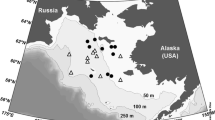Abstract
Global warming has led to a strong deterioration of the Arctic sea ice cover. Ice thickness, age and coverage have been strongly declining in recent years. Brine channels that form in sea ice when seawater freezes represent a unique habitat for bacteria, algae, proto- and small metazoans. We hypothesized that the loss of multi-year ice and the more prevalent formation of first-year ice even in central regions of the Arctic will lead to changes in the Arctic sea ice meiofauna community composition. We therefore analysed the sea ice meiofauna community composition of three different ice types sampled in summer and autumn 2007. Young, thin ice of few cm thickness was typified by taxa of pelagic origin or with good swimming abilities (ciliates, pelagic foraminifera, rotifers and platyhelminthes). Harpacticoid copepods and nematodes with poor swimming abilities were prevalent in older, thicker (>0.5 m) first- and multi-year ice. Brash ice—which was likely a mix of older broken ice, slush and pancake ice—was characterized by a high abundance of platyhelminthes and rotifers. An experimental analysis of colonization efficiencies of artificial thin ice also revealed that species with poor swimming ability are less successful to colonize newly forming thin ice. We conclude that observed and predicted changes in the ice formation regime will likely result in changes in the composition of Arctic sea ice communities. We predict negative effects particularly for species with low dispersal capacities like harpacticoid copepods and endemic nematodes, as these are less successful in colonizing newly forming thin ice.




Similar content being viewed by others
References
Ackley SF (1982) Ice scavenging and nucleation: two mechanisms for incorporation of algae into newly-formed sea ice. EOS 63:54–55
Barber DG, Galley R, Asplin MG, DeAbreu R, Warner K-A, Pucko M, Gupta M, Prinsenberg S, Julien S (2009) Perennial pack ice in the southern Beaufort Sea was not as it appeared in the summer of 2009. Geophys Res Lett. doi:10.1029/2009GL041434
Barnhart KR, Miller CR, Overeem I, Kay JE (2016) Mapping the future expansion of Arctic open water. Nat Clim Change 6:280–285. doi:10.1038/nclimate2848
Blome D, Riemann F (1999) Antarctic sea ice nematodes, with description of Geomonhystera glaciei sp. nov. (Monhysteridae). Mitt Hamb Zool Mus Inst 96:15–20
Bluhm BA, Gradinger R, Piraino S (2007) First record of sympagic hydroids (Hydrozoa, Cnidaria) in Arctic coastal fast ice. Polar Biol 30:1557–1563
Carey AG Jr (1992) The ice fauna in the shallow southwestern Beaufort Sea, Arctic Ocean. J Mar Syst 3:225–236
Carey AG Jr, Montagna PA (1982) Arctic sea ice faunal assemblage: first approach to description and source of the underice meiofauna. Mar Ecol Prog Ser 8:1–8
Chengalath R (1985) The Rotifera of the Canadian Arctic sea ice, with description of a new species. Can J Zool 63:2212–2218
Clarke KR, Gorley RN (2006) Primer v6: user manual/tutorial. PRIMER-E Ltd, Plymouth, p 190
Clement P (1993) The phylogeny of rotifers: molecular, ultrastructural and behavioural data. Hydrobiologia 255(256):527–544
Frankenstein G, Garner R (1967) Equations for determining the brine volume of sea ice from −0.5 °C to −22.9 °C. J Glaciol 6:943–944
Friedrich C, De Smet WH (2000) The rotifer fauna of Arctic sea ice from the Barents Sea, Laptev Sea and Greenland Sea. Hydrobiologia 432:73–89
Friedrich C, Hendelberg J (2001) On the ecology of Acoela living in the Arctic Sea ice. Belg J Zool 131(Supplement 1):213–216
Garrison DL, Buck KR (1986) Organism losses during ice melting: a serious bias in sea ice community studies. Polar Biol 6:237–239
Garrison DL, Close AR, Reimnitz E (1989) Algae concentrated by frazil ice: evidence from laboratory experiments and field measurements. Antarct Sci 1:313–316
Gradinger RR, Ikävalko J (1998) Organism incorporation into newly forming Arctic sea ice in the Greenland Sea. J Plankton Res 20:871–886
Gradinger RR, Schnack-Schiel SB (1998) Potential effect of ice formation on Antarctic pelagic copepods: salinity induced mortality of Calanus propinquus and Metridia gerlachei in comparison to sympagic acoel turbellarians. Polar Biol 20:139–142
Gradinger RR, Friedrich C, Spindler M (1999) Abundance, biomass and composition of the sea ice biota of the Greenland Sea pack ice. Deep-Sea Res Pt II 46:1457–1472
Gradinger RR, Meiners K, Plumley G, Zhang Q, Bluhm BA (2005) Abundance and composition of the sea-ice meiofauna in off-shore pack ice of the Beaufort Gyre in summer 2002 and 2003. Polar Biol 28:171–181
Gradinger RR, Kaufmann MR, Bluhm BA (2009) Pivotal role of sea ice sediments in the seasonal development of near-shore Arctic fast ice biota. Mar Ecol Prog Ser 394:49–63
Gradinger RR, Bluhm B, Iken K (2010) Arctic sea-ice ridges—safe heavens for sea-ice fauna during periods of extreme ice melt? Deep-Sea Res Pt II 57:86–95
Grainger EH (1991) Exploitation of Arctic sea ice by epibenthic copepods. Mar Ecol Prog Ser 77:119–124
Grainger EH, Mohammed AA (1990) High salinity tolerance in sea ice copepods. Ophelia 31:177–185
Grainger EH, Mohammed AA, Lovrity JE (1985) The sea ice fauna of Frobisher Bay, Arctic Canada. Arctic 38:23–30
Haas C, Pfaffling A, Hendricks S, Rabenstein L, Etienne J-L, Rigor I (2008) Reduced ice thickness in Arctic Transpolar Drift favors rapid ice retreat. Geophys Res Lett. doi:10.1029/2008GL034457
Horner R, Ackley SF, Dieckmann GS, Gulliksen B, Hoshiai T, Legendre L, Melnikov IA, Reeburgh WS, Spindler M, Sullivan CW (1992) Ecology of sea ice biota. 1. Habitat, terminology, and methodology. Polar Biol 12:417–427
Janssen HH, Gradinger R (1999) Turbellaria (Archoophora: Acoela) from Antarctic sea ice endofauna: examination of their micromorphology. Polar Biol 21:410–416
Kern JC, Carey AG Jr (1983) The faunal assemblage inhabiting seasonal sea ice in the nearshore Arctic Ocean with emphasis on copepods. Mar Ecol Prog Ser 10:159–167
Kiko R (2010) Acquisition of freeze protection in a sea-ice crustacean through horizontal gene transfer? Polar Biol 33:543–556
Kiko R, Michels J, Mizdalski E, Schnack-Schiel SB, Werner I (2008) Living conditions, abundance and composition of the metazoan fauna in surface and sub-ice layers in pack ice of the western Weddell Sea during late spring. Deep-Sea Res Pt II 55:1000–1014
Kramer M, Kiko R (2011) Brackish meltponds on Arctic sea ice—a new habitat for marine metazoans. Polar Biol 34:603–608
Kramer M, Swadling KM, Meiners K, Kiko R, Scheltz A, Nicolaus M, Werner I (2011) Antarctic sympagic meiofauna in winter: comparing diversity, abundance and biomass between the western Weddell Sea and the southern Indian Ocean. Deep-Sea Res Pt II 58:1062–1074
Krembs C, Gradinger R, Spindler M (2000) Implications of brine channel geometry and surface area for the interaction of sympagic organisms in Arctic sea ice. J Exp Mar Biol Ecol 243:55–80
Kwok R, Cunningham GF (2015) Variability of Arctic sea ice thickness and volume from CryoSat-2. Phil Trans R Soc A 373:20140517. doi:10.1098/rsta.2014.0157
Kwok R, Cunningham GF, Wensnahan M, Rigor I, Zwally HJ, Yi D (2009) Thinning and volume loss of the Arctic Ocean sea ice cover: 2003–2008. J Geophys Res. doi:10.1029/2009JC005312
Maslanik JA, Fowler C, Stroeve J, Drobot S, Zwally J, Yi D, Emery W (2007) A younger, thinner Arctic ice cover: increased potential for rapid, extensive sea ice loss. Geophys Res Lett. doi:10.1029/2007GL032043
Melia N, Haines K, Hawkins E (2015) Improved Arctic sea ice thickness projections using bias-corrected CMIP5 simulations. Cryosphere 9:2237–2251
Riemann F, Sime-Ngando T (1997) Note on sea-ice nematodes (Monhysteroidea) from Resolute Passage, Canadian High Arctic. Polar Biol 18:70–75
Schünemann H, Werner I (2005) Seasonal variations in distribution patterns of sympagic meiofauna in Arctic pack ice. Mar Biol 146:1091–1102
Serreze MC, Stroeve J (2015) Artic sea ice trends, variability and implications for seasonal ice forecasting. Philos T Roy Soc A 373:20140159. doi:10.1098/rsta.2014.0159
Siebert S, Anton-Erxleben F, Kiko R, Kramer M (2009) Sympagohydra tuuli (Cnidaria, Hydrozoa) – first report from sea ice of the central Arctic Ocean and insights into histology, reproduction and locomotion. Mar Biol 156:541–554
Spindler M, Dieckmann GS (1986) Distribution and abundance of the planktic foraminifer Neogloboquadrina pachyderma in sea ice of the Weddell Sea (Antarctica). Polar Biol 5:185–191
SPSS (2001) SPSS 11.0 brief guide. Upper Saddle River, New Jersey
Stroeve JC, Holland MM, Meier W, Scambos T, Serreze M (2007) Arctic sea ice decline: faster than forecast. Geophys Res Lett. doi:10.1029/2007GL029703
Stroeve JC, Serreze MC, Holland MM, Kay JE, Maslanik J, Barrett AP (2011) The Arctic’s rapidly shrinking sea ice cover: a research synthesis. Clim Change. doi:10.1007/s10584-011-0101-1
Tanimura A, Hoshiai T, Fukuchi M (2002) Change in habitat of the sympagic copepod Paralabidocera antarctica from fast ice to seawater. Polar Biol 25:667–671
Tchesunov A (1986) A new free-living nematode connected with Arctic sea ice. Zoologiceski J 65:1782–1787
Tchesunov AV, Riemann F (1995) Arctic sea ice nematodes (Monhysteroidea) with descriptions of Cryonema crassum gen. n., sp. n. and C. tenue sp. n. Nematologica 41:35–40
Vizcarra N (2016) Sluggish ice growth in the Artic. National Snow and Ice Data Center. http://nsidc.org/arcticseaicenews/2016/11/sluggish-ice-growth-in-the-arctic/. Accessed 9 Nov 2016
Weeks WF, Ackley SF (1986) The growth, structure, and properties of sea ice. In: Untersteiner N (ed) The geophysics of sea ice. NATO Adv Sci Inst Se 146, pp 9–164
Werner I (2006) Seasonal dynamics of sub-ice fauna below pack ice in the Arctic (Fram Strait). Deep-Sea Res Pt I 53:294–309
Acknowledgements
Thanks are first of all due to Iris Werner (Institute for Polar Ecology, Kiel, Germany) for her support during all phases of this study. We are grateful to the captain and the crew of R.V. Polarstern and the chief scientist U. Schauer (Alfred-Wegener-Institute, Bremerhaven, Germany) for constant support during ARK XXII/2. Thanks are also due to the reviewers who helped to improve the manuscript. The help of many colleagues, in particular A. Schneider (Institute for Polar Ecology, Kiel) and S. Siebert (University of California, Davis, USA), during the ice and laboratory work is gratefully acknowledged. Parts of this study were funded by a grant of the German Science Foundation (WE 2536/11–1,–2.). Most of the work presented here was organized with support and conducted at the former Institute for Polar Ecology, Kiel, Germany. Rainer Kiko, Henrike Mütze and Maike Kramer conducted their PhD theses at the Institute for Polar Ecology and would like to thank all colleagues for their support.
Author information
Authors and Affiliations
Corresponding author
Electronic supplementary material
Below is the link to the electronic supplementary material.
Rights and permissions
About this article
Cite this article
Kiko, R., Kern, S., Kramer, M. et al. Colonization of newly forming Arctic sea ice by meiofauna: a case study for the future Arctic?. Polar Biol 40, 1277–1288 (2017). https://doi.org/10.1007/s00300-016-2052-5
Received:
Revised:
Accepted:
Published:
Issue Date:
DOI: https://doi.org/10.1007/s00300-016-2052-5




